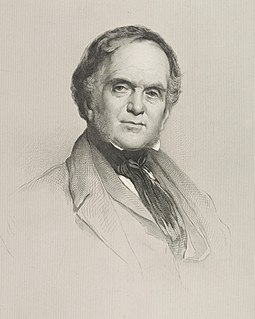
William Henry PlayfairFRSE was a prominent Scottish architect in the 19th century, who designed the Eastern, or Third, New Town and many of Edinburgh's neoclassical landmarks.

Newington is a largely residential area around Newington Road in Southern Edinburgh, Scotland.
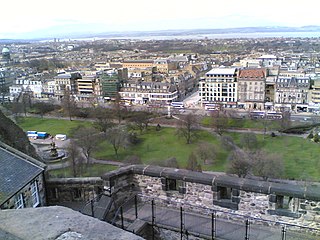
The New Town is a central area of Edinburgh, the capital of Scotland. It was built in stages between 1767 and around 1850, and retains much of its original neo-classical and Georgian period architecture. Its best known street is Princes Street, facing Edinburgh Castle and the Old Town across the geological depression of the former Nor Loch. Together with the Old Town, the New Town was designated a UNESCO World Heritage Site in 1995. The area is also famed for the New Town Gardens, a heritage designation since March 2001.

Stockbridge is a suburb of Edinburgh, located north of the city centre, bounded by the New Town and by Comely Bank. The name is Scots stock brig from Anglic stocc brycg, meaning a timber bridge. Originally a small outlying village, it was incorporated into the City of Edinburgh in the 19th century. The current "Stock Bridge", built in 1801, is a stone structure spanning the Water of Leith. The painter Henry Raeburn (1756–1823) owned two adjoining estates, Deanhaugh and St Bernard's, which he developed with the assistance of the architect James Milne. Milne was also responsible for the fine St Bernard's Church (1823) in Saxe Coburg Street. Ann Street, designed by Raeburn and named after his wife, is a rare early example of a New Town street with private front gardens.
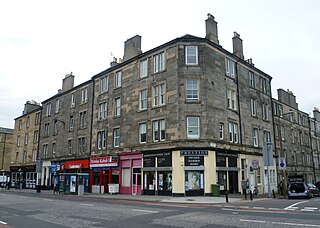
Dalry is an area of the Scottish capital city of Edinburgh. It is located close to the city centre, between Haymarket and Gorgie. The area is now primarily residential. It is centred around Dalry Road, which has numerous shops, restaurants and small businesses. Lying outside the old city walls and west of the castle, the area began as part of the agricultural estate of Dalry House, the exception being the Dalry Mill, recorded as the oldest paper mill in Scotland, now demolished. In the Victorian period industrial development followed along with large scale tenement construction, new road layouts and the addition of railway infrastructure, all of which came to occupy the former fields. By the early 21st century most of the industry of Dalry has disappeared, with the former sites converted to private housing.

St Andrew's and St George's West Church serves Edinburgh's New Town, in Scotland. It is a congregation of the Church of Scotland. The parish today constitutes the whole of the First New Town of Edinburgh and a small part of the early-19th-century Second New Town of Edinburgh. The church building was completed in 1784, and is now protected as a category A listed building.

The Grange is a suburb of Edinburgh, about 1 mile (1.6 km) south of the city centre, with Morningside and Greenhill to the west, Newington to the east, and Marchmont to the north. It is a conservation area characterised by large early Victorian stone-built villas and mansions, often with very large gardens.

St Mary's Cathedral or the Cathedral Church of Saint Mary the Virgin is a cathedral of the Scottish Episcopal Church in the West End of Edinburgh, Scotland. It was built in the late 19th century in the West End of Edinburgh's New Town. The cathedral is the see of the Bishop of Edinburgh, one of seven bishops within the Episcopal Church, which is part of the Anglican Communion. Designed in a Gothic style by Sir George Gilbert Scott, the cathedral is now protected as a category A listed building. and part of the Old Town and New Town of Edinburgh World Heritage Site. Reaching 90 metres (295 ft), its spire makes the building the highest in the Edinburgh urban area.

Bonnington is a district of Edinburgh, the capital of Scotland. The area centres upon an original village which grew up around a ford on the Water of Leith on the old boundary between Edinburgh and the port of Leith. Before the creation of Leith Walk the road via the villages of Broughton and Bonnington, or Wester Road as it appears on some old maps, was one of two roads formerly connecting Edinburgh to Leith; the other being Easter Road. The district lies between the districts of Pilrig and Newhaven.
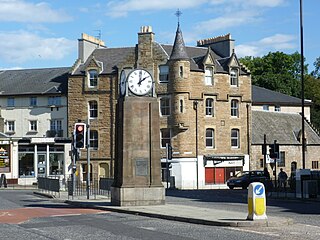
Canonmills is a district of Edinburgh, the capital of Scotland. It lies to the south east of the Royal Botanic Garden at Inverleith, east of Stockbridge and west of Bellevue, in a low hollow north of Edinburgh's New Town. The area was formerly a loch which was drained in three phases in the 18th and 19th centuries, disappearing finally in 1865.

The colony houses of Edinburgh were built between 1850 and 1910 as homes for artisans and skilled working-class families by philanthropic model dwellings companies. The first development was the Pilrig Model Buildings, near Leith Walk. Later developments across the city were built by the Edinburgh Cooperative Building Company Limited, founded in 1861. The founders of this company were influenced by the Reverend Dr. James Begg and the Reverend Dr. Thomas Chalmers, ministers of the Free Church of Scotland, who campaigned to improve the housing conditions of the poor.

Great Junction Street is a street in Leith, on the northern outskirts of Edinburgh, Scotland. It runs southeast to northwest following approximately the southwestmost line of the old town walls around Leith.

Abbeygreen Church is a reformed, evangelical, congregation of the Free Church of Scotland in the small town of Lesmahagow, South Lanarkshire. As a Christian congregation it holds the Word of God, the Holy Bible, as the supreme rule of life and doctrine and holds the Westminster Confession of Faith as a sub-ordinate standard, which helps explain the doctrines of the Christian faith. Being Presbyterian, it serves as part of the Free Church of Scotland Presbytery of Glasgow and seeks to faithfully serve God in Lesmahagow and the surrounding area. Having a missional outlook it is involved with a number of missionary organizations including, but not only, UFM Worldwide and Rose of Sharon Ministries, and helps with the organization and support of the Scottish Reformed Conference.
Rev John Sinclair (1842–1892) was a Liberal Party politician in the United Kingdom. He was elected as a Member of Parliament for Ayr Burghs, in Scotland, in 1888, resigning in 1890 by becoming Steward of the Manor of Northstead.
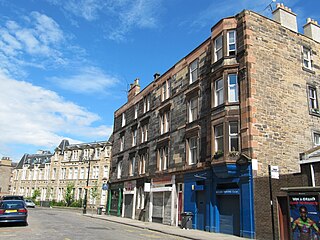
Henderson Street is a street in Leith, a district of the city of Edinburgh, Scotland. It forms a curving artery between Great Junction Street and an area known as the Shore, where the Water of Leith runs into the Port of Leith/Leith Docks. Henderson Street lies within the boundaries of the Leith Conservation Area and includes several listed buildings.
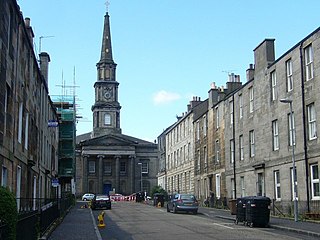
North Leith Parish Church is a congregation of the Church of Scotland, within the Presbytery of Edinburgh. It is serves part of Leith, formerly an independent burgh and since 1920 a part of the city of Edinburgh, Scotland.
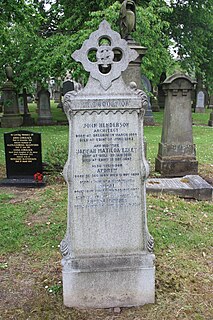
John Henderson was a Scottish architect operational in the mid-19th century. He is chiefly remembered as a church architect, with his early work being in the Gothic revival and tractarian style, before developing his own distinct style.

David Cousin was a Scottish architect, landscape architect and planner, closely associated with early cemetery design and many prominent buildings in Edinburgh. From 1841 to 1872 he operated as Edinburgh’s City Superintendent of Works.
James Henderson was a Scottish minister of the Free Church of Scotland who served as Moderator of the General Assembly to the Free Church 1855/56.
George Ramsay Davidson (1801–1890) was a Scottish minister in the 19th century who was senior minister of the influential Lady Glenorchy's Church and Lady Glenorchy's Free Church.

















